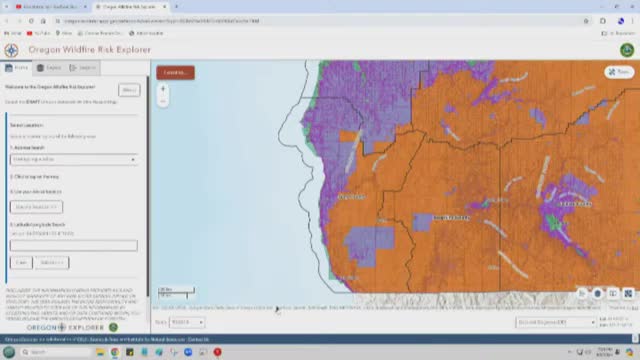Wildfire mapping project sparks controversy over insurance impacts
September 09, 2024 | Brookings, Curry County, Oregon
This article was created by AI summarizing key points discussed. AI makes mistakes, so for full details and context, please refer to the video of the full meeting. Please report any errors so we can fix them. Report an error »

In a recent government meeting, officials discussed the implications of the wildfire mapping project initiated by Senate Bill 762 and furthered by Senate Bill 80. The project aims to create an advanced wildfire hazard map that identifies areas at risk based on various factors, including climate, weather, topography, and vegetation. This map is intended to guide investments to enhance community resilience against wildfires.
However, concerns were raised regarding the effectiveness of community engagement in the mapping process. Despite three discussion sessions held with county leaders, many participants felt their feedback was largely ignored. Out of 36 counties represented, attendees expressed frustration over the lack of meaningful dialogue and the perceived dismissal of their concerns.
The map categorizes areas into high, moderate, and low wildfire risk, indicated by color codes. Critics pointed out inconsistencies in the risk assessments, particularly in Curry County, where local conditions such as coastal moisture and prevailing winds were not adequately considered. This has led to skepticism about the map's integrity and the metrics used to determine risk levels.
Significant changes to building codes are anticipated in high and moderate risk areas, which could lead to increased construction costs. For instance, new regulations may require homes to be built with flame-retardant materials, raising expenses for homeowners and developers alike.
Moreover, the mapping project has already begun to affect homeowners' insurance policies. Although the legislation states that insurance companies should not use the risk assessment map for evaluating properties, many residents report difficulties in obtaining or renewing insurance. Instances were cited where homeowners faced drastic increases in premiums or outright denial of coverage, with wildfire risk being cited as the primary reason.
As the mapping project progresses, officials and community members continue to grapple with its implications, raising questions about the balance between necessary wildfire risk assessments and the economic impact on local residents.
However, concerns were raised regarding the effectiveness of community engagement in the mapping process. Despite three discussion sessions held with county leaders, many participants felt their feedback was largely ignored. Out of 36 counties represented, attendees expressed frustration over the lack of meaningful dialogue and the perceived dismissal of their concerns.
The map categorizes areas into high, moderate, and low wildfire risk, indicated by color codes. Critics pointed out inconsistencies in the risk assessments, particularly in Curry County, where local conditions such as coastal moisture and prevailing winds were not adequately considered. This has led to skepticism about the map's integrity and the metrics used to determine risk levels.
Significant changes to building codes are anticipated in high and moderate risk areas, which could lead to increased construction costs. For instance, new regulations may require homes to be built with flame-retardant materials, raising expenses for homeowners and developers alike.
Moreover, the mapping project has already begun to affect homeowners' insurance policies. Although the legislation states that insurance companies should not use the risk assessment map for evaluating properties, many residents report difficulties in obtaining or renewing insurance. Instances were cited where homeowners faced drastic increases in premiums or outright denial of coverage, with wildfire risk being cited as the primary reason.
As the mapping project progresses, officials and community members continue to grapple with its implications, raising questions about the balance between necessary wildfire risk assessments and the economic impact on local residents.
View full meeting
This article is based on a recent meeting—watch the full video and explore the complete transcript for deeper insights into the discussion.
View full meeting
